_We may earn revenue from the products available on this page and participate in affiliate programs. Learn more ›
_
Best Overall
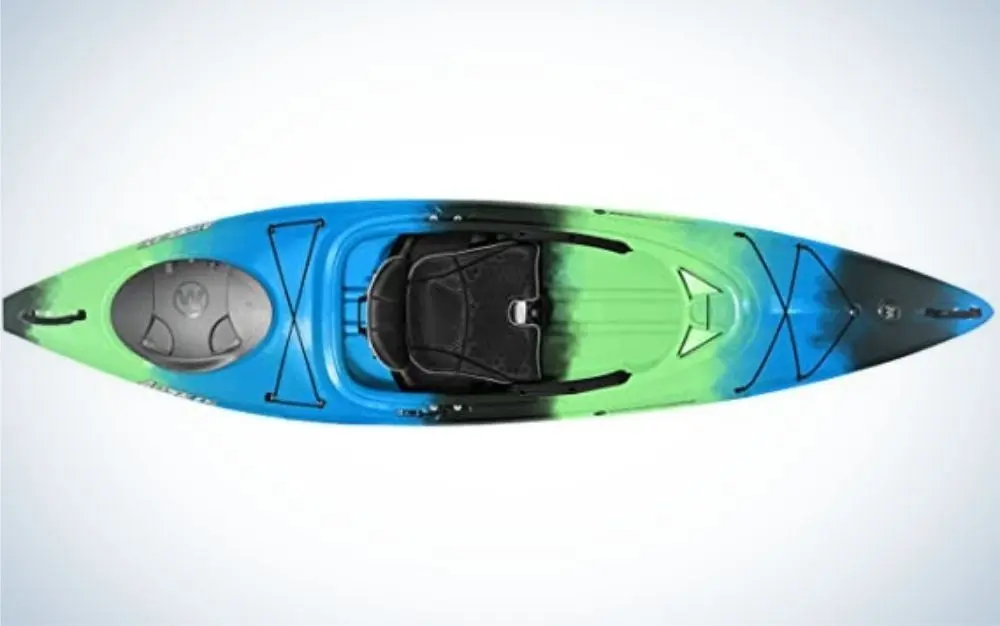
Wilderness Systems Aspire 105
LEARN MORE
Summary
Stable, easy to maneuver, and versatile from calm to moving water, the Wilderness Systems Aspire 105 is the best all-purpose river kayak.
Best for Beginners
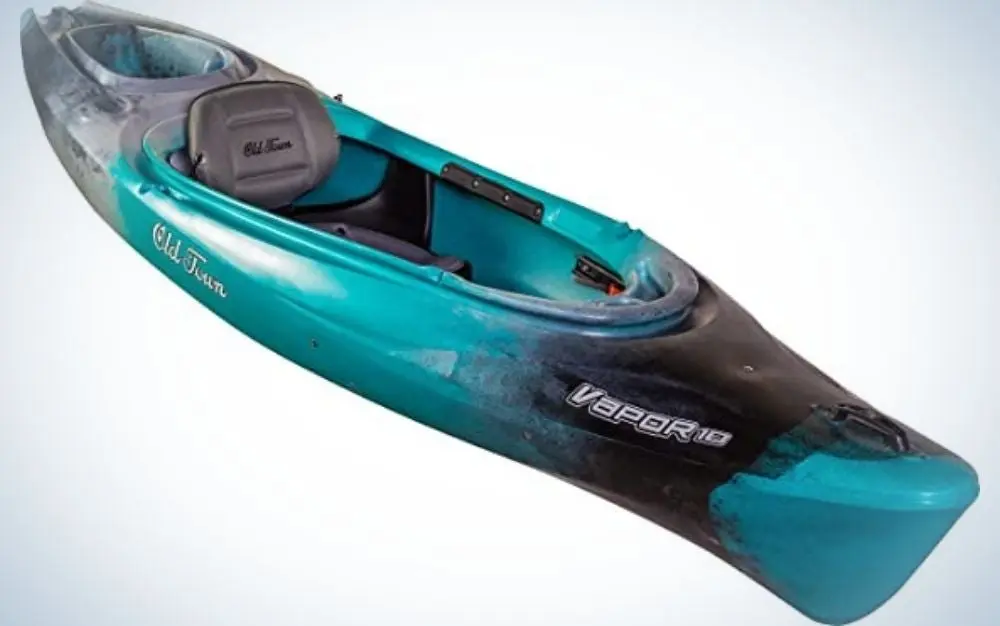
Old Town Vapor 10 Recreational Kayak
LEARN MORE
Summary
A large cockpit to easily enter an exit and a stable ride make the Old Town Vapor 10 the best river kayak for beginners.
Best Budget
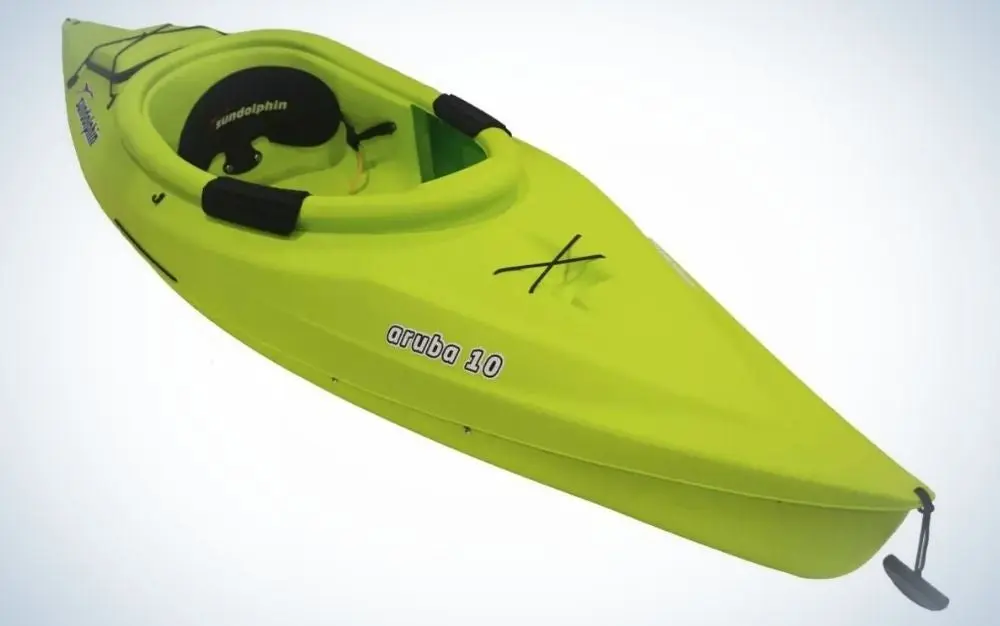
Sun Dolphin Aruba 10
LEARN MORE
Summary
Wide open cockpit, steady handling, and affordability make the Sun Dolphin Aruba 10 the best budget river kayak.
The first thing to consider when looking for river kayaks is your intended use, kayaking style, and type of water it will be floating. Short, lightweight kayaks are perfect to cruise a quick moving river, while a longer and stronger boat will have the storage and steadiness for a multi-day camping trip. Spending the day fishing on the river? You’ll be happiest with a fishing kayak packed with all the bells and whistles designed for a comfortable day reeling it in.
Before jumping down to our top picks, read through the buyer’s guide. You’ll discover the things you need to know to find the best river kayaks for your needs.
Best Overall: Wilderness Systems Aspire 105
Best for River Camping: Eddyline Skylark
Best for River Fishing: Bonafide Kayak SS127
Best for Beginners: Old Town Vapor 10 Recreational Kayak
Best Inflatable: Advanced Elements Advancedframe
Best for River Rapids: Dagger Rewind
Best for River Running: Dagger Katana
Best Budget: Sun Dolphin Aruba 10
Best Overall: Wilderness Systems Aspire 105
Best Overall

Why It Made the Cut: Stable, easy to maneuver, and versatile for calm to moving water, the Wilderness Systems Aspire 105 is the best all-purpose river kayak.
Key Features
Weight: 48 pounds
Length: 10 feet 6 inches
Seating: Sit-in
Type: Recreational
Pros
Versatile in flat and moving water
Extremely Stable
Maneuverable around obstacles
Cons
Heavy
This sit-in kayak is the best overall for river kayaking. Great for everyone from beginners to the experienced, its versatility makes it a great recreational kayak. From the wide opening, to the padded ergonomic seat, to the adjustable thigh braces, the Wilderness Systems Aspire 105 has comfort in mind. In addition, adjustable foot braces allow for stability and comfort on long trips. This boat has solid storage, with a rear waterproof hatch, as well as bungee rigging to keep essentials within arm’s reach.
One of the best parts of this kayak is the adjustable skeg—a drop-down fin on the keel—that provides stability and helps the craft track straight in choppy water. It is rated to a 400-pound capacity so it can handle its rider and as well as a hefty amount of gear. Even though the boat is on the heavy side, comfortable carrying handles make it easy to transport with two people.
Best for River Camping: Eddyline Skylark
Best for River Camping
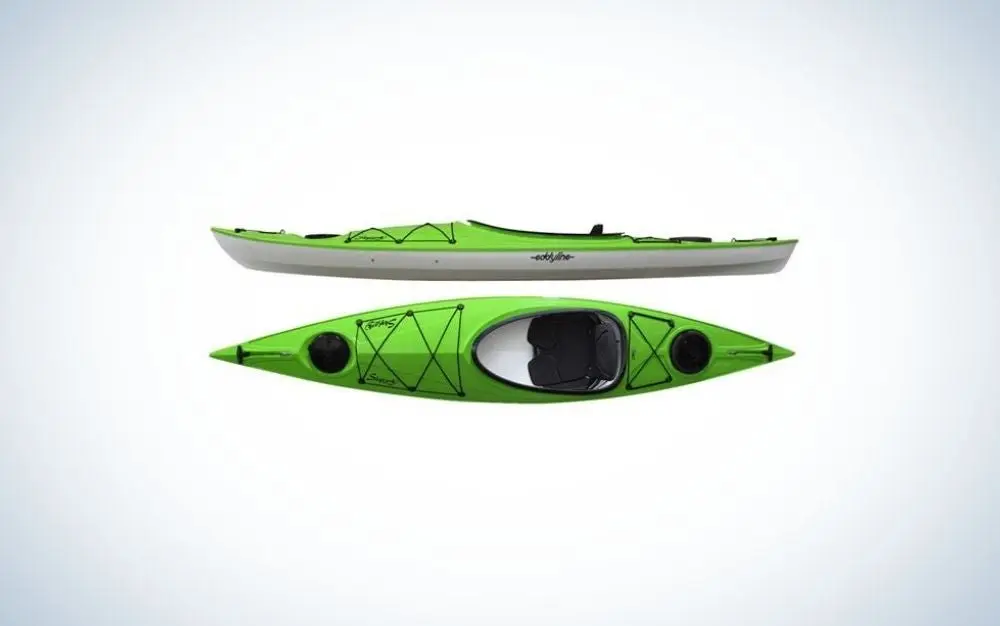
Why It Made the Cut: The Eddyline Skylark is a long recreational kayak that sports watertight storage and a sleek ride making it the best kayak for river camping and river trips.
Key Features
Weight: 41 pounds
Length: 12 feet
Seating: Sit-in
Type: Recreational/touring hybrid
Pros
Watertight storage
Fast
Lightweight
Cons
Expensive
While technically a recreational kayak by length, the Eddyline Skylark has some touring kayak features and design elements which makes it the best choice for camping and long distance river trips.
This is a narrow and lightweight sit-in kayak with an adjustable comfort seat. As a result, it’s energy efficient; easy to paddle and move through the water so riders can spend the day paddling without being spent. Front and rear bulkhead watertight storage compartments mean there’s room to store camping gear for your river trip. The medium-sized cockpit can accommodate a spray skirt.
This kayak is best for slow moving rivers and lakes. It’s the prettiest kayak of the bunch but comes with a price tag to match. However, it’s the best choice if you’re going to spend multiple days on the river and hauling gear.
Best for River Fishing: Bonafide Kayak SS127
Best for River Fishing
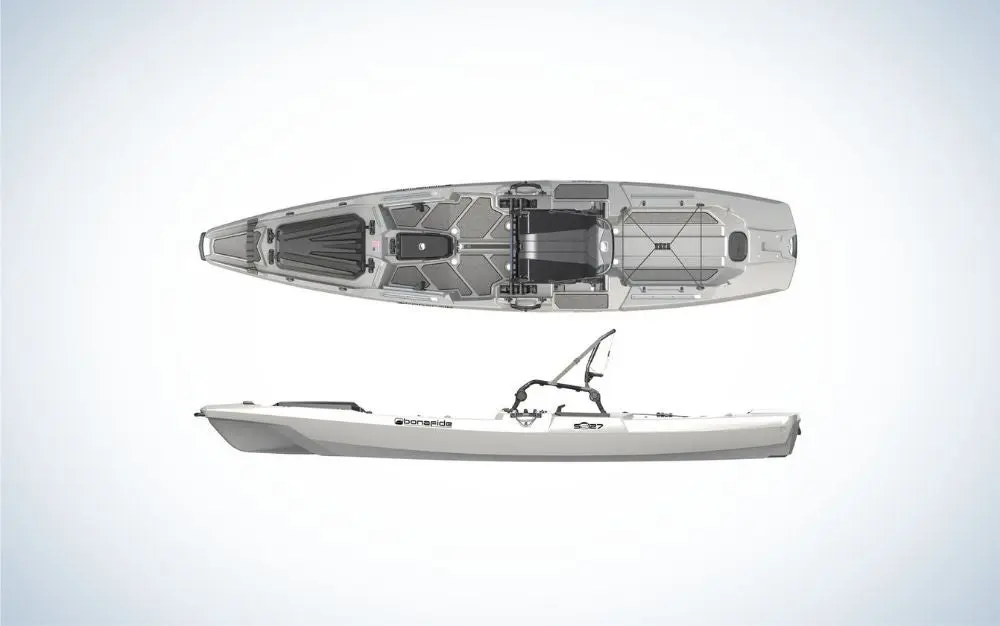
Why It Made the Cut: Bonafide’s SS127 is steady whether you’re sitting, standing, or reeling in a big catch. This sit-on kayak was designed for the comfort and convenience of fishermen.
Key Features
Weight: 94 pounds
Length: 12 feet 7 inches
Seating: Sit-on/stand
Type: Recreational, fishing
Pros
Comfortable
Stable
Convenient
Cons
Heavy
The Bonafide SS127
is a sit-on recreational utility kayak specifically designed for fishing and in my opinion, the best kayak for river fishing. It is a heavy, stable craft designed with the intention that the user will be sitting, standing, and moving over the kayak.
Comfort is key with a high seat designed for long days in the saddle and emphasis on ergonomics with easily adjustable foot braces. Every part of the deck has fishing in mind. Some of the many fishing features include grooves for fishing rods, rod staging area, oversized forward hatch, dry pod storage, gear tracks, and a tank well to fit a cooler. The kayak has the ability to add a trolling motor or rudder system which makes it versatile, and frees your hands for fishing. This boat has capacity to hold 475 pounds so no fear adding coolers, gear, and more. With a fully rigged weight of 94 pounds, this kayak is a beast to haul.
Best for Beginners: Old Town Vapor 10 Recreational Kayak
Best for Beginners

Why It Made the Cut: A large cockpit to easily enter an exit and a stable ride make the Old Town Vapor 10 the best river kayak for beginners.
Key Features
Weight: 47 pounds
Length: 10 feet
Seating: Sit-in
Type: Recreational
Pros
Comfortable
Stable
Easy entry/exit
Cons
Minimal Storage
Beginners are often intimidated by entering and exiting the cockpit in a sit-in kayak for fear it will tip. The Old Town Vapor 10, and larger 10XT, have one of the largest cockpit openings of a recreational sit-in kayak. The large opening is also great for fishing, photography, or bringing a small child in your lap. The boat has an adjustable, comfortable seat so beginners will have an easy entry into the sport of kayaking.
The Old Town Vapor tracks and maneuvers easily. Foam inserts add to buoyancy so paddlers will feel safe and stable. For storage, this kayak has an open well in the stern which is useful for a small cooler or dry bag. But since this boat doesn’t offer any watertight hatches, it’s not a great choice for camping or long river trips. Overall, this is a good kayak for beginners and short excursions on the river.
Best Inflatable: Advanced Elements Advancedframe
Best Inflatable
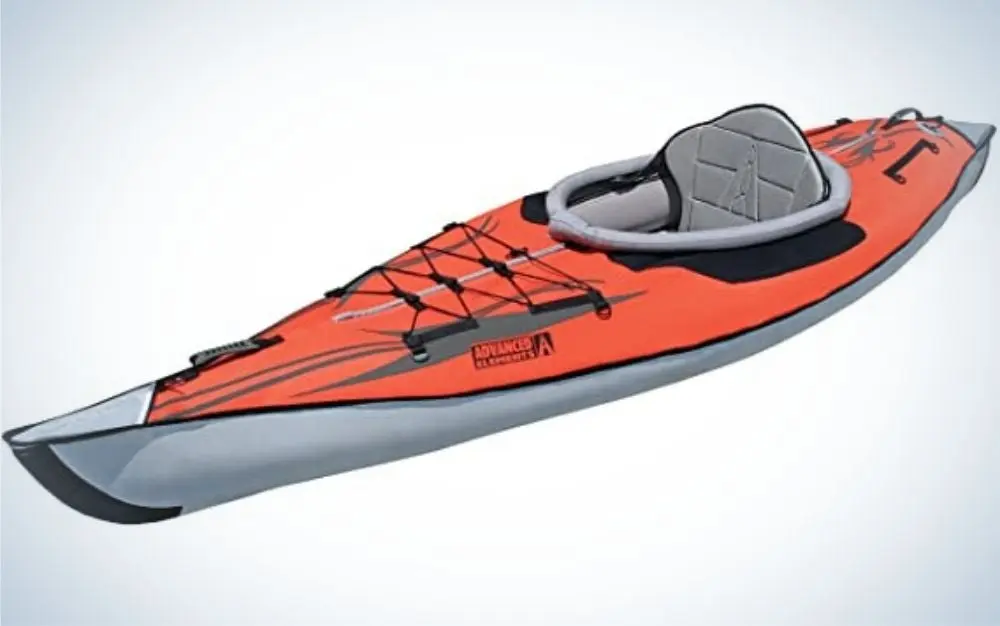
Why It Made the Cut: This durable and stable inflatable kayak by Advanced Elements handles well and is the perfect choice for an easy-to-store kayak.
Key Features
Weight: 36 pounds
Length: 10 feet
Seating: Sit-in
Type: Recreational
Pros
Packable and Storable
Comfortable
Durable
Cons
Time consuming inflation/deflation
Inflatable kayaks have a reputation for less stability and tracking in the water. The raft-like qualities of most inflatables often make them poor choices in windy weather or rough water. But the Advanced Elements Advancedframe is surprisingly high performing. An internal aluminum frame provides structure and allows this inflatable to outperform some of its non-inflatable competition as well as handle a variety of river conditions.
This sit-in, recreational kayak has a comfortable seat and a narrow cockpit reminiscent of a touring kayak. The Advancedframe doesn’t have storage so while it’s great for a day trip, it’s not meant for camping trips or multi-day excursions.
The best part of this boat is that you don’t need a roof rack to haul it or a garage to store it. The kit can easily fit in a small trunk. With this convenience it’s important to note that it takes about 10 minutes or more to inflate with each use.
Best for River Rapids: Dagger Rewind
Best for River Rapids
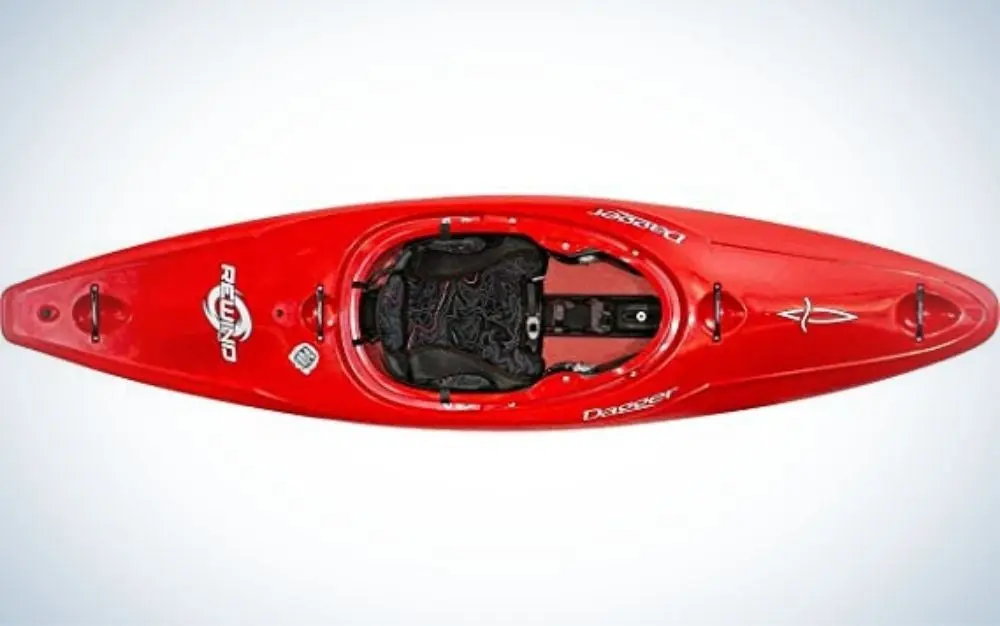
Why It Made the Cut: If you’re going to hit white water, this is your kayak. The Dagger Rewind is designed for Class I-V rivers and is ready to help you down river rapids.
Key Features
Weight: 43 pounds
Length: 8 feet 9 inches
Seating: Sit-in
Type: Whitewater
Pros
Rocker hull for riding rapids
Comfortable
Durable
Cons
Tippy in flat water
Once trained in whitewater kayaking, the rivers are your playground. If you are ready to hit the rapids, you’ll want a whitewater kayak to get you through. The Dagger Rewind has a rocker hull—meant to rock like a rocking horse as it moves over rapids instead of tipping like its flat bottomed recreational counterparts. For those with the skills, the stern cut allows skilled paddlers to slice through rapids and even get vertical without capsizing.
This kayak has a padded adjustable seat that offers comfort as well as adjustable foot braces for stability. When looking for a kayak to run river rapids, sizing is important for safety. This boat is specifically designed to rock through the waves so beginners will find it tippy without the practice and training needed for kayaking rapids.
Best for River Running: Dagger Katana
Best for River Running
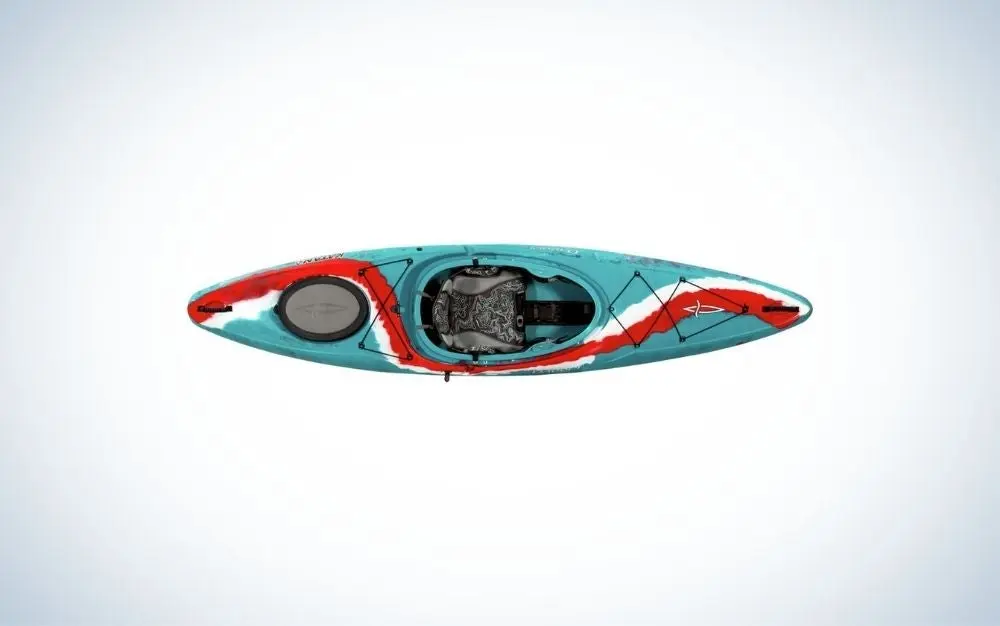
Why It Made the Cut: This crossover kayak can handle pretty much anything the river will give you: calm water, rapids, or narrow inlets. The Katana is the best kayak for river running.
Key Features
Weight: 50 pounds
Length: 9 feet 7 inches
Seating: Sit-in
Type: Recreational/whitewater crossover
Pros
Drop skeg for stability
Watertight Storage
Versatile
Cons
Heavy
The Dagger Katana is a recreational/whitewater hybrid, perfect for all day river running. This sit-in kayak has many features of a whitewater kayak, including a rocker profile. This means it is designed to rock with rapids without tipping over. It also has a hull designed for initial stability making it a great entry boat for those starting on river runs with some small rapids. Unlike a traditional whitewater boat, the Katana has a wider cockpit and hatch storage. It also has a drop skeg—a drop down fin on the keel—that helps the boat track in winds and rough water. With its versatility and ability to handle every type of river, the Dagger Katana is also one of the safest kayaks for beginners.
It’s difficult to find fault with this kayak, but its durability comes in a heavy package. Owners might find its 50-pound dry weight a lot to maneuver off the water. Still, the hybrid design makes it one of the best river kayaks.
Best Budget: Sun Dolphin Aruba 10
Best Budget

Why It Made the Cut: Wide open cockpit, steady handling, and affordability make the Sun Dolphin Aruba 10 the best budget river kayak.
Key Features
Weight: 40 pounds
Length: 10 feet
Seating: Sit-in
Type: Recreational
Pros
Affordable
Lightweight
Stable
Cons
Seat lacks padding
With a price tag under $300, the Sun Dolphin Aruba 10 is a bargain. This sit-in recreational kayak is lightweight and has a large open cockpit that beginners will find easy to get in and out on shore or dock. The flat bottom hull provides initial stability on calm water but won’t handle rapids well. For a budget boat, the Sun Dolphin has some great features. These include adjustable foot braces for comfort and stability, bow water bottle holder with bungee, stern storage compartment, and carrying handles. Comfort comes at a price however, and the most notable here is the lack of cushioning on the seat. Without a padded seat, it’s great for short trips on the river, but best to pick a more comfortable boat like the Wilderness Systems Aspire 105
, for an all-day affair.
Things to Consider Before Buying a River Kayak
The term “river kayak” encompasses a large range of kayak designs. Rivers vary from calm, flat water to raging rapids. The activities available on your vessel could include calm paddling, wildlife viewing, fishing, or river running. Breakdown what you want to do with your boat and follow this guide for the best river kayaks.
Kayak Type
Kayaks come in three main types: recreational, touring, and whitewater. The obvious difference between the three types is the length of the boat, but there are other design differences too.
Recreational: A recreational kayak is the most common type used on rivers. These kayaks are generally plastic and durable. Recreational kayaks are recognizable by being shorter (8-12 feet) and wider than their touring counterparts. This makes them sturdy and maneuverable. As a result, they are perfect for beginners and casual day use. They make good river kayaks and are the most versatile if you aren’t sure where you’ll be paddling.
Touring: Touring kayaks are meant for long day trips or even multi-day excursions. They achieve more control, speed, and efficiency than their recreational counterparts with longer designs (over 10 feet), rudders or skegs (keel fin), and more cargo storage. Sea kayaks are a type of touring kayak meant for open ocean. While steady and fast, their long size is usually not optimal for rivers. Touring kayaks can come in plastic as well as fiberglass or wood.
Whitewater: Whitewater kayaks are best for navigating rapids and fast-moving water. The short design (4 to 8 feet) allows maneuverability. A spray skirt prevents water from entering the cockpit and a hearty, plastic hull can handle pounding water as well as rocks and sand. Whitewater kayaking is a high-risk sport that requires training by professionals.
Kayak Seating
Kayaks come in two main seating options: sit-in or sit-on kayaks. There are pros and cons to both designs.
Sit-in Kayak: In a sit-in kayak, your legs will be inside a cockpit. These are found in recreational, touring, and whitewater designs. With your center of gravity lower, these kayaks tend to be faster as well as more comfortable in colder temperatures and rougher water. A spray skirt can be added to prevent water from coming into the cockpit, as well as protecting the user from sun and spray. It is important to learn (and even practice) how to do a wet exit with a spray skirt in this type of kayak should you capsize.
Sit-on-Top Kayak: The sit-on kayaks for rivers are generally meant for calm water. Without a cockpit, it’s likely you’ll get wet, so this design is best used for milder temperatures. These make great river fishing kayaks where accessories like rod holders or coolers allow for versatility.
Additional Features
Some additional features are available for each paddler’s specific needs. Some of these options include:
Packable kayaks: available in foldable and inflatable options
Pedal kayaks: keep your hands free by pedaling instead of paddling
Tandem: a two-person kayak for double power
Motorized: feature a motor for all day river touring with no exertion
For more info one each type of kayak, you can check out our roundups. Review the top options in pedal kayaks
, the best sit-on-tops for fishing
, top choices in fishing kayaks
, and the best fishing kayaks under $1000
. You can also read our reviews of the Nucanoe Frontier 12
, and Vibe Shearwater 125
. And be sure to review our picks for the best kayak paddles
. And make sure you’re prepared before hitting the river. A good start is reading these guidelines from American Whitewater
.
FAQs
Q: Is river kayaking dangerous?
River kayaking can be dangerous. Like any form of outdoor recreation, it’s important to think of safety before partaking in the activity. To make sure you have a fun and safe experience check the weather, make and share a float plan with someone, and avoid kayaking alone.
For any kayak trip, bring essential safety gear including: a PFD, whistle, communication device, towline, spare paddle, bilge pump, first aid kit, water, and a headlamp. Be aware of hazards on the water and know your abilities when it comes to whitewater and navigation. River kayaking is a fun and life-long form of recreation that can be very safe if you plan ahead and be prepared.
Q: What length kayak is best for rivers?
Recreational kayak length of about 8 to 13 feet is usually best for rivers. This medium length of kayak allows paddlers to meander through tight inlets as well as cut through open water. There are some exceptions. For those river-running on rapids, a whitewater kayak of about six feet would be a better fit. What’s more, for large, calm rivers, fjords, and estuaries – a touring river kayak or sea kayak of 12 to 17 feet is preferable.
Q: Are sit-on-top kayaks good for rivers?
Sit-on-top kayaks are good for rivers when the water is relatively calm and flat. Sit-on kayaks place the center of weight higher up which can make them more vulnerable to tipping in rapids or waves. If you’re planning a slow river run, it is enjoyable to sit up and give a longer distance view of the river ahead. Sit-on kayaks are usually better for fishing as well.
Final Thoughts
Whether you’re spending an hour on a calm creek, or an adrenaline river run for days, there’s a kayak to meet your needs. Make plans to spend time on the water and check out my list of the best river kayaks. Be safe on the water and have fun!
Methodology
I come from a paddling family. My father writes for paddling magazines, my sister guided sea kayaking expeditions in Alaska, and my mom planned our family vacations around sea kayaking destinations. Kayaking has been part of my identity for as long as I can remember. My personal expertise comes from guiding multi-day paddling trips in New Hampshire and Maine. From choppy lakes to rushing rivers to coastal seas, I’ve learned how your boat can make or break your day. When looking for the best river kayaks for this article, I focused on the following criteria:
Functionality: Does the kayak do what it’s intended? If the plan is a lazy day down a slow-moving river, the Dagger Rewind isn’t going to be your boat. But if you are looking for something that can handle some rapids, strap in! Kayaks have very intended uses whether that’s a stable toy for kids or beginners or a well-designed tool to handle rocks and rapids. I chose the best in each category based on their intended use.
Value: A kayak is a sizable purchase—both for storage and also price. I looked for boats that would provide years of use and were worth the cost. Once you know what you’re looking for, the best pick will mean you won’t have to buy another.
Handling: There are some river kayaks that are more work than others. The best picks handle well and allow you to enjoy your day on the water, not fight with bad design.
![Field & Stream [dev]](https://images.ctfassets.net/fbkgl98xrr9f/1GnddAVcyeew2hQvUmrFpw/e4ca91baa53a1ecd66f76b1ef472932b/mob-logo.svg)





